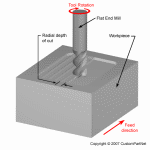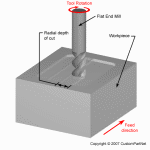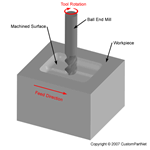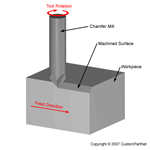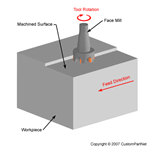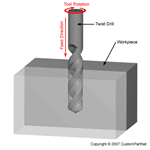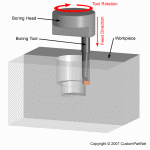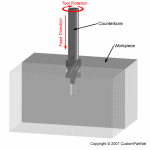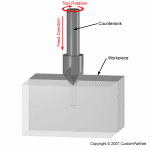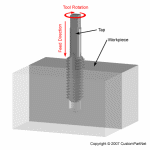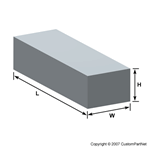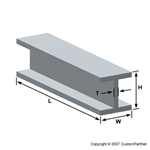- Processes
- Polymer Processing
- Blow Molding
- Injection Molding
- Metal Injection Molding
- Thermoforming
- Metal Casting
- Centrifugal Casting
- Die Casting
- Investment Casting
- Permanent Mold
- Sand Casting
- Shell Mold Casting
- Machining
- Milling
- Turning
- Hole-making
- Drill Size Chart
- Tap Size Chart
- Sheet Metal Fabrication
- Forming
- Cutting with shear
- Cutting without shear
- Gauge Size Chart
- Additive Fabrication
- SLA
- FDM
- SLS
- DMLS
- 3D Printing
- Inkjet Printing
- Jetted Photopolymer
- LOM
- Materials
- Metals
- Plastics
- Case Studies
- Cost Analysis
- Part Redesign
- Product Development
- Resources
- Curriculum Resources
- Glossary
Milling is the most common form of
machining, a material removal process, which can create
a variety of features on a part by cutting away the
unwanted material. The milling process requires a
milling machine, workpiece,
fixture, and cutter. The
workpiece is a piece of pre-shaped material that is
secured to the fixture, which itself is attached to a
platform inside the milling machine. The cutter is a
cutting tool with sharp teeth that is also secured in
the milling machine and rotates at high speeds. By
feeding the workpiece into the rotating cutter, material
is cut away from this workpiece in the form of small
chips to create the desired shape.
Milling is typically used to
produce parts that are not axially symmetric and have
many features, such as holes, slots, pockets, and even
three dimensional surface contours. Parts that are
fabricated completely through milling often include
components that are used in limited quantities, perhaps
for prototypes, such as custom designed fasteners or
brackets. Another application of milling is the
fabrication of tooling for other processes. For example,
three-dimensional molds are typically milled. Milling is
also commonly used as a secondary process to add or
refine features on parts that were manufactured using a
different process. Due to the high tolerances and
surface finishes that milling can offer, it is ideal for
adding precision features to a part whose basic shape
has already been formed.
Capabilities
Disclaimer: All process specifications reflect the approximate range of a process's capabilities and should be viewed only as a guide. Actual capabilities are dependent upon the manufacturer, equipment, material, and part requirements.
Return to top | ||||||||||||||||||||||||||||||||||||||
Process Cycle
The time required to produce a given quantity of parts includes the initial setup time and the cycle time for each part. The setup time is composed of the time to setup the milling machine, plan the tool movements (whether performed manually or by machine), and install the fixture device into the milling machine. The cycle time can be divided into the following four times:
- Load/Unload time - The time required to load the workpiece into the milling machine and secure it to the fixture, as well as the time to unload the finished part. The load time can depend on the size, weight, and complexity of the workpiece, as well as the type of fixture.
- Cut time - The time required for the cutter to make all the necessary cuts in the workpiece for each operation. The cut time for any given operation is calculated by dividing the total cut length for that operation by the feed rate, which is the speed of the cutter relative to the workpiece.
- Idle time - Also referred to as non-productive time, this is the time required for any tasks that occur during the process cycle that do not engage the workpiece and therefore remove material. This idle time includes the tool approaching and retracting from the workpiece, tool movements between features, adjusting machine settings, and changing tools.
- Tool replacement time - The time required to replace a tool that has exceeded its lifetime and therefore become to worn to cut effectively. This time is typically not performed in every cycle, but rather only after the lifetime of the tool has been reached. In determining the cycle time, the tool replacement time is adjusted for the production of a single part by multiplying by the frequency of a tool replacement, which is the cut time divided by the tool lifetime.
Following the milling process
cycle, there is no post processing that is required.
However, secondary processes may be used to improve the
surface finish of the part if it is required. The scrap
material, in the form of small material chips cut from
the workpiece, is propelled away from the workpiece by
the motion of the cutter and the spraying of lubricant.
Therefore, no process cycle step is required to remove
the scrap material, which can be collected and discarded
after the production.
Cutting parameters
In milling, the speed and motion of the cutting tool is
specified through several parameters. These parameters
are selected for each operation based upon the workpiece
material, tool material, tool size, and more.
- Cutting feed - The distance that the cutting tool or workpiece advances during one revolution of the spindle and tool, measured in inches per revolution (IPR). In some operations the tool feeds into the workpiece and in others the workpiece feeds into the tool. For a multi-point tool, the cutting feed is also equal to the feed per tooth, measured in inches per tooth (IPT), multiplied by the number of teeth on the cutting tool.
- Cutting speed - The speed of the workpiece surface relative to the edge of the cutting tool during a cut, measured in surface feet per minute (SFM).
- Spindle speed - The rotational speed of the spindle and tool in revolutions per minute (RPM). The spindle speed is equal to the cutting speed divided by the circumference of the tool.
- Feed rate - The speed of the cutting tool's movement relative to the workpiece as the tool makes a cut. The feed rate is measured in inches per minute (IPM) and is the product of the cutting feed (IPR) and the spindle speed (RPM).
- Axial depth of cut - The depth of the tool along its axis in the workpiece as it makes a cut. A large axial depth of cut will require a low feed rate, or else it will result in a high load on the tool and reduce the tool life. Therefore, a feature is typically machined in several passes as the tool moves to the specified axial depth of cut for each pass.
- Radial depth of cut - The depth of the tool along its radius in the workpiece as it makes a cut. If the radial depth of cut is less than the tool radius, the tool is only partially engaged and is making a peripheral cut. If the radial depth of cut is equal to the tool diameter, the cutting tool is fully engaged and is making a slot cut. A large radial depth of cut will require a low feed rate, or else it will result in a high load on the tool and reduce the tool life. Therefore, a feature is often machined in several steps as the tool moves over the step-over distance, and makes another cut at the radial depth of cut.
Operations
During the process cycle, a variety of operations may be performed to the workpiece to yield the desired part shape. The following operations are each defined by the type of cutter used and the path of that cutter to remove material from the workpiece.
Return to top
Equipment
Milling machines can be found in a variety of sizes and designs, yet they still possess the same main components that enable the workpiece to be moved in three directions relative to the tool. These components include the following:
- Base and column - The base of a milling machine is simply the platform that sits on the ground and supports the machine. A large column is attached to the base and connects to the other components.
- Table - The workpiece that will be milled is mounted onto a platform called the table, which typically has "T" shaped slots along its surface. The workpiece may be secured in a fixture called a vise, which is secured into the T-slots, or the workpiece can be clamped directly into these slots. The table provides the horizontal motion of the workpiece in the X-direction by sliding along a platform beneath it, called the saddle.
- Saddle - The saddle is the platform that supports the table and allows its longitudinal motion. The saddle is also able to move and provides the horizontal motion of the workpiece in the Y-direction by sliding transversely along another platform called the knee.
- Knee - The knee is the platform that supports the saddle and the table. In most milling machines, sometimes called column and knee milling machines, the knee provides the vertical motion (Z direction) of the workpiece. The knee can move vertically along the column, thus moving the workpiece vertically while the cutter remains stationary above it. However, in a fixed bed machine, the knee is fixed while the cutter moves vertically in order to cut the workpiece.
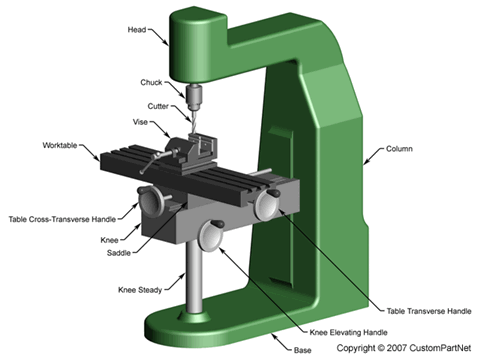
Manual vertical milling machine
The above components of the milling
machine can be oriented either vertically or
horizontally, creating two very distinct forms of
milling machine. A horizontal milling machine uses a
cutter that is mounted on a horizontal shaft, called an
arbor, above the workpiece. For this reason, horizontal
milling is sometimes referred to as arbor milling. The
arbor is supported on one side by an overarm, which is
connected to the column, and on the other side by the
spindle. The spindle is driven by a motor and therefore
rotates the arbor. During milling, the cutter rotates
along a horizontal axis and the side of the cutter
removes material from the workpiece. A vertical milling
machine, on the other hand, orients the cutter
vertically. The cutter is secured inside a piece called
a collet, which is then attached to the vertically
oriented spindle. The spindle is located inside the
milling head, which is attached to the column. The
milling operations performed on a vertical milling
machine remove material by using both the bottom and
sides of the cutter.
Milling machines can also be
classified by the type of control that is used. A manual
milling machine requires the operator to control the
motion of the cutter during the milling operation. The
operator adjusts the position of the cutter by using
hand cranks that move the table, saddle, and knee.
Milling machines are also able to be computer
controlled, in which case they are referred to as a
computer numerical control (CNC) milling machine. CNC
milling machines move the workpiece and cutter based on
commands that are preprogrammed and offer very high
precision. The programs that are written are often
called G-codes or NC-codes. Many CNC milling machines
also contain another axis of motion besides the standard
X-Y-Z motion. The angle of the spindle and cutter can be
changed, allowing for even more complex shapes to be
milled.
Return to top
Tooling
The tooling that is required for
milling is a sharp cutter that will be rotated by the
spindle. The cutter is a cylindrical tool with sharp
teeth spaced around the exterior. The spaces between the
teeth are called flutes and allow the material chips to
move away from the workpiece. The teeth may be straight
along the side of the cutter, but are more commonly
arranged in a helix. The helix angle reduces the load on
the teeth by distributing the forces. Also, the number
of teeth on a cutter varies. A larger number of teeth
will provide a better surface finish. The cutters that
can be used for milling operations are highly diverse,
thus allowing for the formation of a variety of
features. While these cutters differ greatly in
diameter, length, and by the shape of the cut they will
form, they also differ based upon their orientation,
whether they will be used horizontally or vertically.
A cutter that will be used in a
horizontal milling machine will have the teeth extend
along the entire length of the tool. The interior of the
tool will be hollow so that it can be mounted onto the
arbor. With this basic form, there are still many
different types of cutters that can be used in
horizontal milling, including those listed below.
- Plane (helical) mill
- Form relieved mill
- Staggered tooth mill
- Double angle mill
Another operation known as a
straddle milling is also possible with a horizontal
milling machine. This form of milling refers to the use
of multiple cutters attached to the arbor and used
simultaneously. Straddle milling can be used to form a
complex feature with a single cut.
For vertical milling machines, the
cutters take a very different form. The cutter teeth
cover only a portion of the tool, while the remaining
length is a smooth surface, called the shank. The shank
is the section of the cutter that is secured inside the
collet, for attachment to the spindle. Also, many
vertical cutters are designed to cut using both the
sides and the bottom of the cutter. Listed below are
several common vertical cutters.
- Flat end mill
- Ball end mill
- Chamfer mill
- Face mill
- Twist drill
- Reamer
- Tap
All cutters that are used in milling can be found in a variety of materials, which will determine the cutter's properties and the workpiece materials for which it is best suited. These properties include the cutter's hardness, toughness, and resistance to wear. The most common cutter materials that are used include the following:
- High-speed steel (HSS)
- Carbide
- Carbon steel
- Cobalt high speed steel
The material of the cutter is chosen based upon a number of factors, including the material of the workpiece, cost, and tool life. Tool life is an important characteristic that is considered when selecting a cutter, as it greatly affects the manufacturing costs. A short tool life will not only require additional tools to be purchased, but will also require time to change the tool each time it becomes too worn. The cutters listed above often have the teeth coated with a different material to provide additional wear resistance, thus extending the life of the tool. Tool wear can also be reduced by spraying a lubricant and/or coolant on the cutter and workpiece during milling. This fluid is used to reduce the temperature of the cutter, which can get quite hot during milling, and reduce the friction at the interface between the cutter and the workpiece, thus increasing the tool life. Also, by spraying a fluid during milling, higher feed rates can be used, the surface finish can be improved, and the material chips can be pushed away. Typical cutting fluids include mineral, synthetic, and water soluble oils.
Return to top
Materials
In milling, the raw form of the material is a piece of stock from which the workpieces are cut. This stock is available in a variety of shapes such as flat sheets, solid bars (rectangular, cylindrical, hexagonal, etc.), hollow tubes (rectangular, cylindrical, etc.), and shaped beams (I-beams, L-beams, T-beams, etc.). Custom extrusions or existing parts such as castings or forgings are also sometimes used.
Milling can be performed on workpieces in variety of materials, including most metals and plastics. Common materials that are used in milling include the following:
- Aluminum
- Brass
- Magnesium
- Nickel
- Steel
- Thermoset plastics
- Titanium
- Zinc
When selecting a material, several factors must be considered, including the cost, strength, resistance to wear, and machinability. The machinability of a material is difficult to quantify, but can be said to posses the following characteristics:
- Results in a good surface finish
- Promotes long tool life
- Requires low force and power to mill
- Provides easy collection of chips
Return to top
Possible Defects
Most defects in milling are inaccuracies in a feature's dimensions or surface roughness. There are several possible causes for these defects, including the following:
- Incorrect cutting parameters - If the cutting parameters such as the feed rate, spindle speed, or axial depth of cut are too high, the surface of the workpiece will be rougher than desired and may contain scratch marks or even burn marks. Also, a large depth of cut may result in vibration of the cutter and cause inaccuracies in the cut.
- Dull cutter - As a cutter is used, the teeth will wear down and become dull. A dull cutter is less capable of making precision cuts.
- Unsecured workpiece - If the workpiece is not securely clamped in the fixture, the friction of milling may cause it to shift and alter the desired cuts.
Return to top
Design Rules
- Select a material that minimizes overall cost. An inexpensive workpiece may result in longer cut times and more tool wear, increasing the total cost
- Minimize the amount of milling that is required by pre-cutting the workpiece close to the desired size and shape
- Select the size of the workpiece such that a large enough surface exists for the workpiece to be securely clamped. Also, the clamped surface should allow clearance between the tool and the fixture for any cuts
Features
- Minimize the number of setups that are required by designing all features on one side of the workpiece, if possible
- Design features, such as holes and threads, to require tools of standard sizes
- Minimize the number of tools that are required
- Ensure that the depth of any feature is less than the tool length and therefore will avoid the collet contacting the workpiece
- Lower requirements for tolerance and surface roughness, if possible, in order to reduce costs
- Design internal vertical edges to have a corner radius equal to that of a standard tool. If another component with an external sharp edge must fit, then drill a hole to provide a relief area
- Avoid very long and thin features
- Use chamfers rather than a corner radius for outside horizontal edges
- Avoid undercuts
Return to top
Cost Drivers
The material cost is determined by the quantity of material stock that is required and the unit price of that stock. The amount of stock is determined by the workpiece size, stock size, method of cutting the stock, and the production quantity. The unit price of the material stock is affected by the material and the workpiece shape. Also, any cost attributed to cutting the workpieces from the stock also contributes to the total material cost.
Production cost
The production cost is a result of the total production time and the hourly rate. The production time includes the setup time, load time, cut time, idle time, and tool replacement time. Decreasing any of these time components will reduce cost. The setup time and load time are dependent upon the skill of the operator. The cut time, however, is dependent upon many factors that affect the cut length and feed rate. The cut length can be shortened by optimizing the number of operations that are required and reducing the feature size if possible. The feed rate is affected by the operation type, workpiece material, tool material, tool size, and various cutting parameters such as the axial depth of cut. Lastly, the tool replacement time is a direct result of the number of tool replacements which is discussed regarding the tooling cost.
Tooling cost
The tooling cost for machining is determined by the total number of cutting tools required and the unit price for each tool. The quantity of tools depends upon the number of unique tools required by the various operations to be performed and the amount of wear that each of those tools experience. If the tool wear exceeds the lifetime of a tool, then a replacement tool must be purchased. The lifetime of a tool is dependant upon the tool material, cutting parameters such as cutting speed, and the total cut time. The unit price of a tool is affected by the tool type, size, and material.
Return to top

